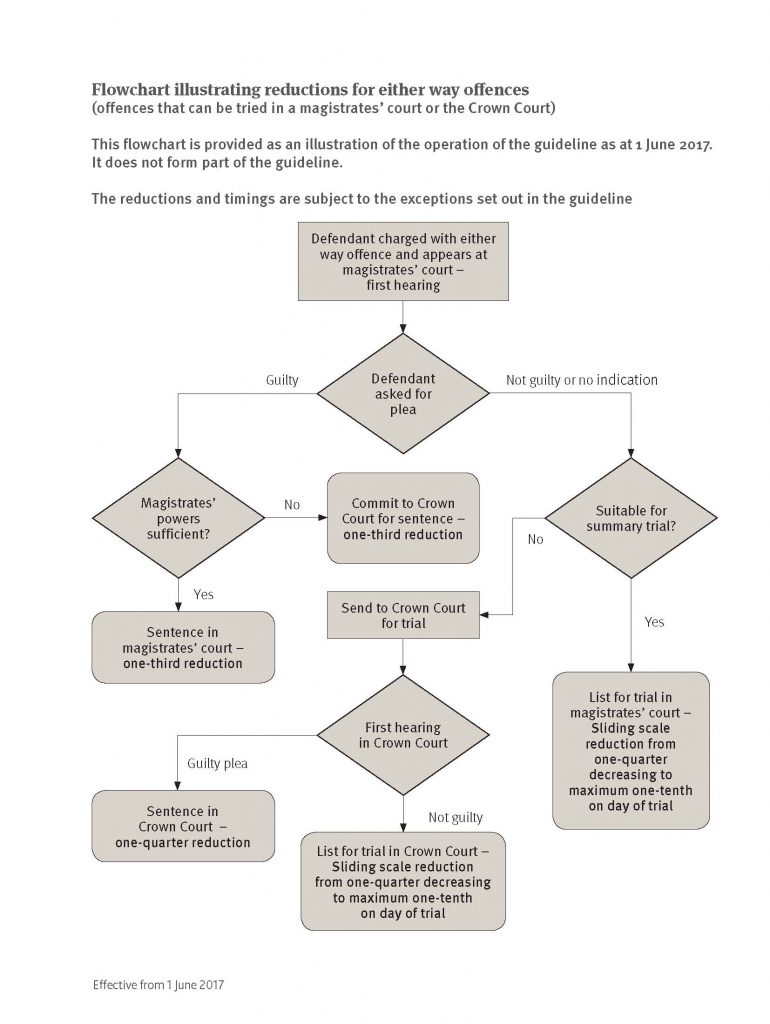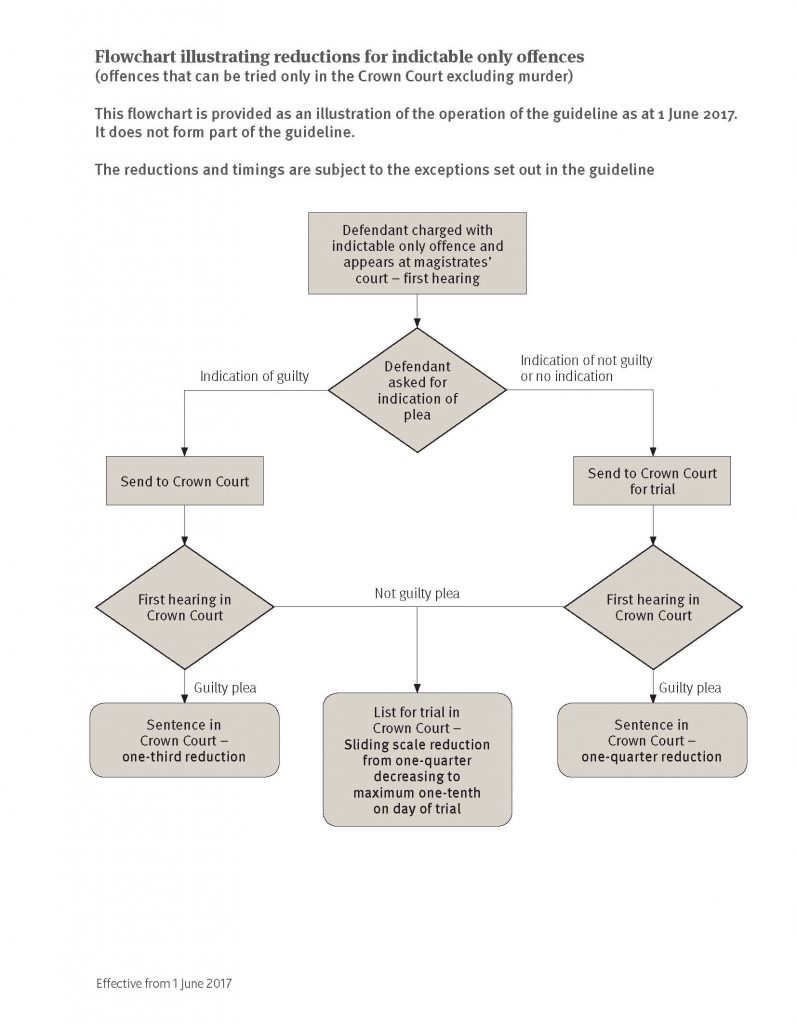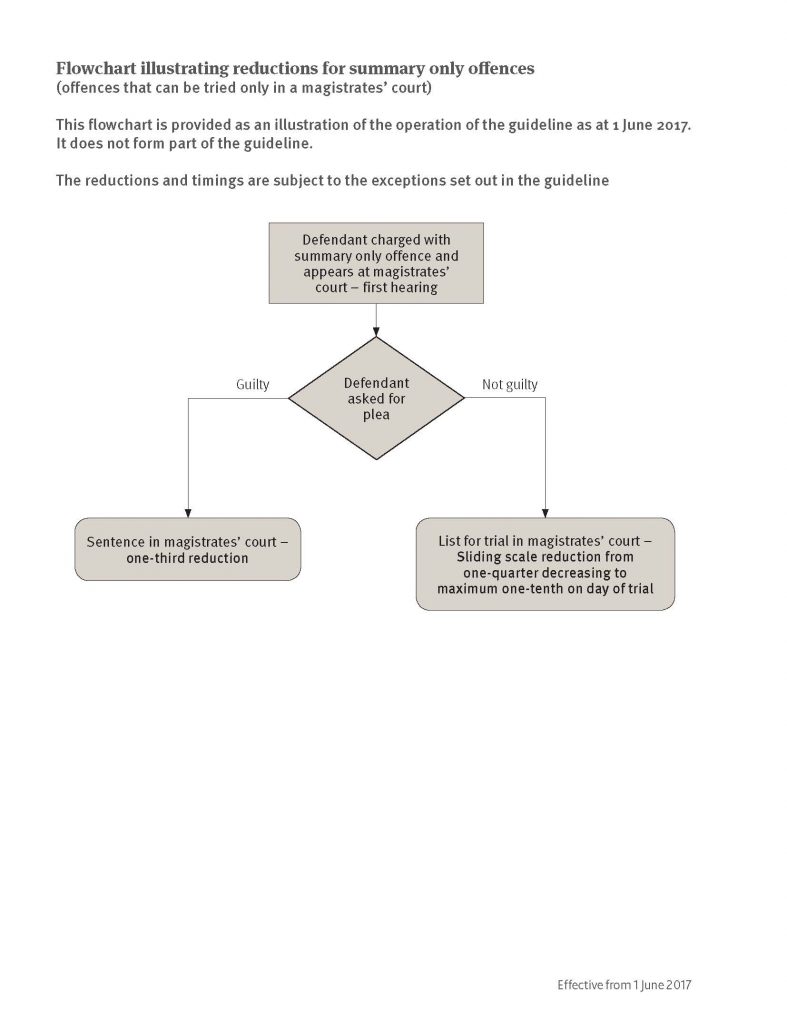(For cases where the first hearing was before 1 June 2017 please refer to the earlier guideline)
Section 73 of the Sentencing Code provides:
(1) This section applies where a court is determining what sentence to pass on an offender who has pleaded guilty to an offence1 in proceedings before that or another court.
(2) The court must take into account the following matters—
(a) the stage in the proceedings for the offence at which the offender indicated the intention to plead guilty, and
(b) the circumstances in which the indication was given.
Nothing in this guideline affects the duty of the parties to progress cases (including the service of material) and identify any issues in dispute in compliance with the Criminal Procedure Rules and Criminal Practice Directions.
Guideline users should be aware that the Equal Treatment Bench Book covers important aspects of fair treatment and disparity of outcomes for different groups in the criminal justice system. It provides guidance which sentencers are encouraged to take into account wherever applicable, to ensure that there is fairness for all involved in court proceedings.
The Sentencing Council issues this definitive guideline in accordance with section 120 of the Coroners and Justice Act 2009.
Section 59(1) of the Sentencing Code provides that:
“Every court - (a) must, in sentencing an offender, follow any sentencing guidelines which are relevant to the offender’s case, and (b) must, in exercising any other function relating to the sentencing of offenders, follow any sentencing guidelines which are relevant to the exercise of the function, unless the court is satisfied that it would be contrary to the interests of justice to do so.”
This guideline applies regardless of the date of the offence to all individual offenders aged 18 and older and to organisations in cases where the first hearing is on or after 1 June 2017. The guideline applies equally in magistrates’ courts and the Crown Court. Guidance on reductions in sentence for a guilty plea for under 18s is contained in the Sentencing Council Overarching Principles - Sentencing Children and Young People guideline to which sentencers should refer.
B. Key principles
The purpose of this guideline is to encourage those who are going to plead guilty to do so as early in the court process as possible. Nothing in the guideline should be used to put pressure on a defendant to plead guilty.
Although a guilty person is entitled not to admit the offence and to put the prosecution to proof of its case, an acceptance of guilt:
- normally reduces the impact of the crime upon victims;
- saves victims and witnesses from having to testify; and
- is in the public interest in that it saves public time and money on investigations and trials.
A guilty plea produces greater benefits the earlier the plea is indicated. In order to maximise the above benefits and to provide an incentive to those who are guilty to indicate a guilty plea as early as possible, this guideline makes a clear distinction between a reduction in the sentence available at the first stage of the proceedings and a reduction in the sentence available at a later stage of the proceedings.
The purpose of reducing the sentence for a guilty plea is to yield the benefits described above. The guilty plea should be considered by the court to be independent of the offender’s personal mitigation.
- Factors such as admissions at interview, co-operation with the investigation and demonstrations of remorse should not be taken into account in determining the level of reduction. Rather, they should be considered separately and prior to any guilty plea reduction, as potential mitigating factors.
- The benefits apply regardless of the strength of the evidence against an offender. The strength of the evidence should not be taken into account when determining the level of reduction.
- The guideline applies only to the punitive elements of the sentence and has no impact on ancillary orders including orders of disqualification from driving.
C. The Approach
| Stage 1 | Determine the appropriate sentence for the offence(s) in accordance with any offence specific sentencing guideline. |
| Stage 2 | Determine the level of reduction for a guilty plea in accordance with this guideline. |
| Stage 3 | State the amount of that reduction. |
| Stage 4 | Apply the reduction to the appropriate sentence. |
| Stage 5 | Follow any further steps in the offence specific guideline to determine the final sentence. |
D. Determining the level of reduction
The maximum level of reduction in sentence for a guilty plea is one-third
D1. Plea indicated at the first stage of the proceedings
Where a guilty plea is indicated at the first stage of proceedings a reduction of one-third should be made (subject to the exceptions in section F). The first stage will normally be the first hearing at which a plea or indication of plea is sought and recorded by the court.2
D2. Plea indicated after the first stage of proceedings – maximum one quarter – sliding scale of reduction thereafter
After the first stage of the proceedings the maximum level of reduction is one-quarter (subject to the exceptions in section F).
The reduction should be decreased from one-quarter to a maximum of one-tenth on the first day of trial having regard to the time when the guilty plea is first indicated to the court relative to the progress of the case and the trial date (subject to the exceptions in section F). The reduction should normally be decreased further, even to zero, if the guilty plea is entered during the course of the trial.
For the purposes of this guideline a trial will be deemed to have started when pre-recorded cross‑examination has begun.
E. Applying the reduction
E1. Imposing one type of sentence rather than another
The reduction in sentence for a guilty plea can be taken into account by imposing one type of sentence rather than another; for example:
- by reducing a custodial sentence to a community sentence, or
- by reducing a community sentence to a fine.
Where a court has imposed one sentence rather than another to reflect the guilty plea there should normally be no further reduction on account of the guilty plea. Where, however, the less severe type of sentence is justified by other factors, the appropriate reduction for the plea should be applied in the normal way.
E2. More than one summary offence
When dealing with more than one summary offence, the aggregate sentence is limited to a maximum of six months. Allowing for a reduction for each guilty plea, consecutive sentences might result in the imposition of the maximum six month sentence. Where this is the case, the court may make a modest additional reduction to the overall sentence to reflect the benefits derived from the guilty pleas.
E3. Keeping an either way case in the magistrates’ court to reflect a guilty plea
Reducing a custodial sentence to reflect a guilty plea may enable a magistrates’ court to retain jurisdiction of an either way offence rather than committing the case for sentence to the Crown Court. In such cases a magistrates’ court should apply the appropriate reduction to the sentence for the offence(s) arrived at in accordance with any offence specific sentencing guideline and if the resulting sentence is then within its jurisdiction it should go on to sentence.
F. Exceptions
F1. Further information, assistance or advice necessary before indicating plea
Where the sentencing court is satisfied that there were particular circumstances which significantly reduced the defendant’s ability to understand what was alleged or otherwise made it unreasonable to expect the defendant to indicate a guilty plea sooner than was done, a reduction of one-third should still be made.
In considering whether this exception applies, sentencers should distinguish between cases in which it is necessary to receive advice and/or have sight of evidence in order to understand whether the defendant is in fact and law guilty of the offence(s) charged, and cases in which a defendant merely delays guilty plea(s) in order to assess the strength of the prosecution evidence and the prospects of conviction or acquittal.
F2. Newton Hearings and special reasons hearings
In circumstances where an offender’s version of events is rejected at a Newton hearing3 or special reasons hearing,4 the reduction which would have been available at the stage of proceedings the plea was indicated should normally be halved. Where witnesses are called during such a hearing, it may be appropriate further to decrease the reduction.
F3. Offender convicted of a lesser or different offence
If an offender is convicted of a lesser or different offence from that originally charged, and has earlier made an unequivocal indication of a guilty plea to this lesser or different offence to the prosecution and the court, the court should give the level of reduction that is appropriate to the stage in the proceedings at which this indication of plea (to the lesser or different offence) was made taking into account any other of these exceptions that apply. In the Crown Court where the offered plea is a permissible alternative on the indictment as charged, the offender will not be treated as having made an unequivocal indication unless the offender has entered that plea.
F4. Minimum sentence under section 311 of the Sentencing Code for certain offences involving firearms that are prohibited weapons
There can be no reduction for a guilty plea if the effect of doing so would be to reduce the length of sentence below the required minimum term.
F5. Minimum sentences under sections 268C, 282C, 312, 313, 314 and 315 of the Sentencing Code for persons aged 18 or over
In circumstances where:
- an appropriate custodial sentence of at least 14 years falls to be imposed (under section 268C or 282C of the Sentencing Code) on a person aged 18 or over who has been convicted of a serious terrorism offence (as defined in section 306(2) of the Sentencing Code)
- an appropriate custodial sentence of at least six months falls to be imposed (under section 312 or 315 of the Sentencing Code) on a person aged 18 or over who has been convicted under sections 1 or 1A of the Prevention of Crime Act 1953; or sections 139, 139AA or 139A of the Criminal Justice Act 1988 (certain possession of knives or offensive weapon offences) or
- an appropriate custodial sentence falls to be imposed under section 313 (third class A drug trafficking offence) or section 314 (third domestic burglary) of the Sentencing Code
the court may impose any sentence in accordance with this guideline which is not less than 80 per cent of the appropriate custodial period.5
G. Mandatory life sentences for murder
Murder is the most serious criminal offence and the sentence prescribed is different from all other sentences. By law, the sentence for murder is imprisonment (detention) for life and an offender will remain subject to the sentence for the rest of his life.
Given the special characteristic of the offence of murder and the unique statutory provision in Schedule 21 of the Sentencing Code of starting points for the minimum term to be served by an offender, careful consideration has to be given to the extent of any reduction for a guilty plea and to the need to ensure that the minimum term properly reflects the seriousness of the offence. Whilst the general principles continue to apply (both that a guilty plea should be encouraged and that the extent of any reduction should reduce if the indication of plea is later than the first stage of the proceedings) the process of determining the level of reduction will be different.
Determining the level of reduction
Whereas a court should consider the fact that an offender has pleaded guilty to murder when deciding whether it is appropriate to order a whole life term, where a court determines that there should be a whole life minimum term, there will be no reduction for a guilty plea.
In other circumstances:
- the court will weigh carefully the overall length of the minimum term taking into account other reductions for which the offender may be eligible so as to avoid a combination leading to an inappropriately short sentence;
- where it is appropriate to reduce the minimum term having regard to a plea of guilty, the reduction will not exceed one-sixth and will never exceed five years;
- the maximum reduction of one-sixth or five years (whichever is less) should only be given when a guilty plea has been indicated at the first stage of the proceedings. Lesser reductions should be given for guilty pleas after that point, with a maximum of one-twentieth being given for a guilty plea on the day of trial.
The exceptions outlined at F1 and F2 above, apply to murder cases.
Notes
- ‘Offence’ includes breach of an order where this constitutes a separate criminal offence but not breach of terms of a sentence or licence.
- In cases where (in accordance with the Criminal Procedure Rules) a defendant is given the opportunity to enter a guilty plea without attending a court hearing, doing so within the required time limits will constitute a plea at the first stage of proceedings.
- A Newton hearing is held when an offender pleads guilty but disputes the case as put forward by the prosecution and the dispute would make a difference to the sentence. The judge will normally hear evidence from witnesses to decide which version of the disputed facts to base the sentence on.
- A special reasons hearing occurs when an offender is convicted of an offence carrying mandatory licence endorsement or disqualification from driving and seeks to persuade the court that there are extenuating circumstances relating to the offence that the court should take into account by reducing or avoiding endorsement or disqualification. This may involve calling witnesses to give evidence.
- In accordance with s.73(2A), (3) and (4) of the Sentencing Code.
Flowcharts illustrating reductions
1. Either way offences

Flowchart illustrating reductions for either way offences – download pdf (recommended for iPad)
2. Indictable only offences

Flowchart illustrating reductions for indictable only offences – download pdf (recommended for iPad)
3. Summary only offences

Flowchart illustrating reductions for summary only offences – download pdf (recommended for iPad)